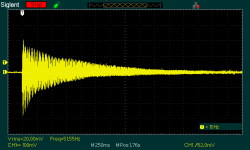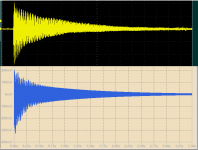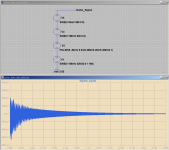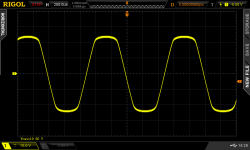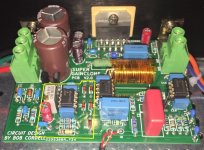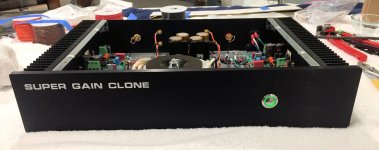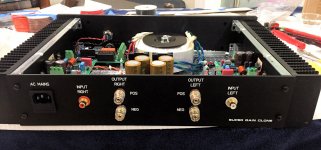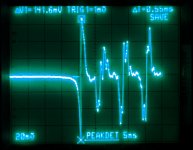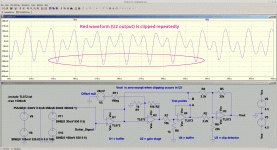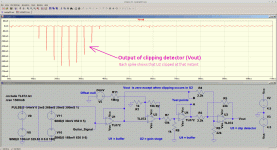For years, I've heard a sort of low-level gritty harshness from solid-state electric guitar amplifiers, when set for clean tone.
I'm talking specifically about solid-state, all-analogue guitar amps that follow the typical recipe: op-amps in the preamplifier, and an IC power amp (or a rarer discrete power amp stage).
For a long time (decades!), the cause of this phenomenon eluded me. I didn't know what caused it, I didn't have the test equipment to capture it, and not every musician even heard it at all.
So it was basically a case of "He said, she said", and that is a very unsatisfactory situation for what is fundamentally an engineering problem.
I think I now finally understand the cause of the harshness I've heard so many times, and I'd like to talk about that in this thread. Hopefully this is of interest to other people who want to build solid-state DIY guitar amplifiers, or simply want to understand them better.
The starting point for all of this is the actual electrical signal from an electric guitar. Exactly what does it look like?
Fortunately for me, Rod Elliott, a name familiar to most DIY electronics enthusiasts, had made a number of measurements of e-guitar signals, with the intention of finding out the amount of voltage that could be expected from a typical e-guitar.
While Elliott's goal was to calculate peak and RMS voltage from a guitar, he also posted screen captures from his oscilloscope on his website: https://www.sound-au.com/articles/guitar-voltage.htm
There are a lot of interesting things to be seen in those guitar signal captures.
More in the next post.
-Gnobuddy
I'm talking specifically about solid-state, all-analogue guitar amps that follow the typical recipe: op-amps in the preamplifier, and an IC power amp (or a rarer discrete power amp stage).
For a long time (decades!), the cause of this phenomenon eluded me. I didn't know what caused it, I didn't have the test equipment to capture it, and not every musician even heard it at all.
So it was basically a case of "He said, she said", and that is a very unsatisfactory situation for what is fundamentally an engineering problem.
I think I now finally understand the cause of the harshness I've heard so many times, and I'd like to talk about that in this thread. Hopefully this is of interest to other people who want to build solid-state DIY guitar amplifiers, or simply want to understand them better.
The starting point for all of this is the actual electrical signal from an electric guitar. Exactly what does it look like?
Fortunately for me, Rod Elliott, a name familiar to most DIY electronics enthusiasts, had made a number of measurements of e-guitar signals, with the intention of finding out the amount of voltage that could be expected from a typical e-guitar.
While Elliott's goal was to calculate peak and RMS voltage from a guitar, he also posted screen captures from his oscilloscope on his website: https://www.sound-au.com/articles/guitar-voltage.htm
There are a lot of interesting things to be seen in those guitar signal captures.
More in the next post.
-Gnobuddy
Let's take a closer look at one of the waveforms from Elliott's page. I picked one that displays several typical characteristics shared by other waveforms on that page.
Elliott says that the vertical scale on all these images is 100mV/division, and the horizontal scale is 250 mS/div. From initial trigger point to the end of each waveform is 3.75 seconds in every case.
Here are a few observations:
1) Initial amplitude is around 500 mV peak-to-peak.
2) The waveform is quite asymmetrical. The initial negative peak is at around -300 mV. The initial positive peak is around +200 mV. The signal is offset below zero volts.
3) One second into the waveform, it's offset the other way - more amplitude above the zero-volt line than below it.
4) The initial amplitude is enormous compared to the amplitude after 3.75 seconds. At the start, the signal is about 500mV peak to peak. At the end, it's too small to make out clearly, but appears to be roughly one small "tick" of the vertical scale - that's 20mV peak-to-peak.
This means the signal starts off 25 times stronger than it ends. That's 28 dB stronger at the start than at the end.
5) There are multiple frequencies present. This can be very clearly seen in the first 0.5 seconds - look at the "beats" in the amplitude. Also, you can see "kinks" in the envelope, as different frequencies die away at different times.
This is not surprising - we know from the physics of vibrating strings that a picked guitar string vibrates not only at its fundamental frequency, but also simultaneously at a number of overtones (higher frequencies).
I say "overtones" rather than "harmonics", because "harmonic" means integer mathematical multiples of the fundamental frequency, such as 220 Hz, 440 Hz, 660 Hz.
"Overtones" only means that the additional frequencies are higher - they don't have to be exactly integer multiples of the fundamental frequency.
An infinitely flexible, massless, lossless string produces true harmonics if picked.
An actual guitar string isn't massless and infinitely flexible. Instead, it has mass, it has stiffness, and it also has internal damping (energy loss).
As a result, each successive overtone tends to fall a little further short of its true harmonic frequency. If the fundamental is 220 Hz, the first overtone will end up at a slightly lower frequency than 440 Hz. The second overtone will be even further short of 660 Hz. And so on.
More in the next post!
-Gnobuddy
Elliott says that the vertical scale on all these images is 100mV/division, and the horizontal scale is 250 mS/div. From initial trigger point to the end of each waveform is 3.75 seconds in every case.
Here are a few observations:
1) Initial amplitude is around 500 mV peak-to-peak.
2) The waveform is quite asymmetrical. The initial negative peak is at around -300 mV. The initial positive peak is around +200 mV. The signal is offset below zero volts.
3) One second into the waveform, it's offset the other way - more amplitude above the zero-volt line than below it.
4) The initial amplitude is enormous compared to the amplitude after 3.75 seconds. At the start, the signal is about 500mV peak to peak. At the end, it's too small to make out clearly, but appears to be roughly one small "tick" of the vertical scale - that's 20mV peak-to-peak.
This means the signal starts off 25 times stronger than it ends. That's 28 dB stronger at the start than at the end.
5) There are multiple frequencies present. This can be very clearly seen in the first 0.5 seconds - look at the "beats" in the amplitude. Also, you can see "kinks" in the envelope, as different frequencies die away at different times.
This is not surprising - we know from the physics of vibrating strings that a picked guitar string vibrates not only at its fundamental frequency, but also simultaneously at a number of overtones (higher frequencies).
I say "overtones" rather than "harmonics", because "harmonic" means integer mathematical multiples of the fundamental frequency, such as 220 Hz, 440 Hz, 660 Hz.
"Overtones" only means that the additional frequencies are higher - they don't have to be exactly integer multiples of the fundamental frequency.
An infinitely flexible, massless, lossless string produces true harmonics if picked.
An actual guitar string isn't massless and infinitely flexible. Instead, it has mass, it has stiffness, and it also has internal damping (energy loss).
As a result, each successive overtone tends to fall a little further short of its true harmonic frequency. If the fundamental is 220 Hz, the first overtone will end up at a slightly lower frequency than 440 Hz. The second overtone will be even further short of 660 Hz. And so on.
More in the next post!
-Gnobuddy
Attachments
The next question is: What happens if we feed this guitar signal straight into an op-amp, set up with a little voltage gain to act as a preamp?
In order to answer that question, I quickly designed a circuit that could detect and display if clipping had occurred. But lacking tons of spare time to build that circuit, I thought it worthwhile to see if I could use LTSpice to simulate the problem.
To do that, we have to start by teaching LTSpice how to create a signal that looks like a typical guitar pickup signal.
This took a fair bit of tinkering (more details soon), but here is the outcome. The yellow trace is Rod Elliott's 'scope capture. The blue trace is from my simulated LTSpice source.
I've scaled both graphs to the same volts/div and time/div, and same physical size, so you can easily compare them by eye.
The blue (LTSpice) waveform doesn't fully reproduce every nuance of the real thing, but I think it captures enough of the salient features to give us a solid starting point.
Note, in particular, that the blue waveform is also asymmetrical, just like the actual guitar signal.
-Gnobuddy
In order to answer that question, I quickly designed a circuit that could detect and display if clipping had occurred. But lacking tons of spare time to build that circuit, I thought it worthwhile to see if I could use LTSpice to simulate the problem.
To do that, we have to start by teaching LTSpice how to create a signal that looks like a typical guitar pickup signal.
This took a fair bit of tinkering (more details soon), but here is the outcome. The yellow trace is Rod Elliott's 'scope capture. The blue trace is from my simulated LTSpice source.
I've scaled both graphs to the same volts/div and time/div, and same physical size, so you can easily compare them by eye.
The blue (LTSpice) waveform doesn't fully reproduce every nuance of the real thing, but I think it captures enough of the salient features to give us a solid starting point.
Note, in particular, that the blue waveform is also asymmetrical, just like the actual guitar signal.
-Gnobuddy
Attachments
A pick produces a much higher peak to start with.
A more mellow tone is got from finger picking.
The signal from an electric guitar is pretty gruesome.
I once tried to digitise one and it was very difficult as positive and negative half cycles were very different.
Quite often it wasnt even near a sine wave.
A more mellow tone is got from finger picking.
The signal from an electric guitar is pretty gruesome.
I once tried to digitise one and it was very difficult as positive and negative half cycles were very different.
Quite often it wasnt even near a sine wave.
Thanks, Nigel!
Good point about pick vs fingers; easy to hear, but I've never thought to record and compare the two waveforms.
I found that I could get close to the representative Rod Elliott waveform by stacking four LTSpice voltage sources in series. One of them is the fundamental at 329.63 Hz (open E on the first string). I added two overtones at frequencies near 660 Hz and 990 Hz, tweaking the frequencies until they produced beats similar to the ones in Elliott's wave capture.
All three sine voltage sources are exponentially damped. I arrived at the decay time by trial and error, to closely match the reference (real) guitar signal.
To generate the asymmetry, I added the fourth source, a slow-going negative pulse that pushes the entire waveform negative for the first few hundred milliseconds, to match the real guitar signal in Elliott's scope capture.
The combination of all four LTSpice voltage sources generates the blue trace in the image I posted previously. It's a pretty good match to most of the features of the Rod Elliott guitar waveform.
Here is my LTSpice circuit. First a screen capture, then the actual sim file (LTSpice .asc file), in case anyone wants to tinker with it.
-Gnobuddy
Good point about pick vs fingers; easy to hear, but I've never thought to record and compare the two waveforms.
I found that I could get close to the representative Rod Elliott waveform by stacking four LTSpice voltage sources in series. One of them is the fundamental at 329.63 Hz (open E on the first string). I added two overtones at frequencies near 660 Hz and 990 Hz, tweaking the frequencies until they produced beats similar to the ones in Elliott's wave capture.
All three sine voltage sources are exponentially damped. I arrived at the decay time by trial and error, to closely match the reference (real) guitar signal.
To generate the asymmetry, I added the fourth source, a slow-going negative pulse that pushes the entire waveform negative for the first few hundred milliseconds, to match the real guitar signal in Elliott's scope capture.
The combination of all four LTSpice voltage sources generates the blue trace in the image I posted previously. It's a pretty good match to most of the features of the Rod Elliott guitar waveform.
Here is my LTSpice circuit. First a screen capture, then the actual sim file (LTSpice .asc file), in case anyone wants to tinker with it.
-Gnobuddy
Attachments
Gnobuddy, I think this is a really good idea and a great starting point. In order to understand the workings of the solid state preamp/amp design, one needs to have good fundamental data about what type signals it will see. I won't jump ahead with any comments, looks good so far! Cheers
The 1969-vintage 741 opamp chip (datasheet attached) has a gain bandwidth product of 1 megahertz. Operating at a gain of ten, with ±15 volt power supplies, it will easily amplify the simulated waveform in post #3. With negligible distortion and no clipping at all.
The 1979-vintage NE5534A opamp chip, with ±18 volt power supplies, will be even better.
_
The 1979-vintage NE5534A opamp chip, with ±18 volt power supplies, will be even better.
_
Attachments
Thank you!Gnobuddy, I think this is a really good idea and a great starting point. In order to understand the workings of the solid state preamp/amp design, one needs to have good fundamental data about what type signals it will see.
My thoughts exactly. We've been simulating and measuring guitar circuits with steady-state sinewaves, just as we do with Hi-Fi audio circuitry. It's now starting to be pretty clear that a steady sine-wave isn't going to reveal the real difficulties in designing a solid-state guitar amplifier.
And if we use a test signal that doesn't reveal the problems, it also means that we won't look for or find solutions to those problems. We can't fix what we're completely unaware of!
My biggest hope for this thread, now that we have a realistic and easy to use simulated guitar signal, is that it helps us design better solid-state guitar amplifiers.
-Gnobuddy
Very true. Going from a maximum unclipped output signal of 6 Vpp, all the way up to 27 Vpp, would be a substantial improvement for the input stage.The 1969-vintage 741 opamp chip (datasheet attached) has a gain bandwidth product of 1 megahertz. Operating at a gain of ten, with ±15 volt power supplies, it will easily amplify the simulated waveform in post #3. With negligible distortion and no clipping at all.
No argument there.
But you're only considering the input stage. What happens further down the signal chain?
A typical solid-state power amplifier, whether discrete or an IC, is basically just an op-amp designed for higher output current (maybe voltage too). It's designed around exactly the same fundamental concept: tons of open-loop gain, and tons of negative feedback to bring closed-loop gain down to where we want it.
Which brings with it exactly the same characteristics as an op-amp. THD is inaudibly low - unless the output is allowed to clip. If it does clip, the NFB forces the clipping to be very abrupt, very harsh, and absolutely horrible sounding.
For Hi-Fi, this is not a problem. Solid-state power amplification is so cheap that it's easy to have plenty of output headroom. That means that during normal use the amplifier never clips. THD stays inaudibly low. It's a perfect solution.
That recipe has been in use for many decades, and it works superbly for Hi-Fi.
But what happens when you feed a guitar signal into that same high-NFB power amplifier?
Now we have exactly the same problem we had with the input-stage op-amp. Each note from the guitar starts off about 30 dB stronger than it ends. If we set out power amplifier so that the initial strong signal isn't clipped, there won't enough volume to be usable a couple of seconds into the note. It will be buried in the rest of the music, and quite inaudible.
So we have to bring up the gain, a lot, so that the guitar note is still audible a second or three after its start.
And that means that the first part of the note, 30 dB stronger, WILL clip.
That in turn means that the guitar amplifier will have that strange simultaneous combination of sounding gritty and harsh, and also "too clean" that has been bothering me for about 37 years now.
Now that we know the cause, it's easy to understand why this is the case. The gritty harshness comes from the hard clipping at the start of the waveform. The "too clean" comes from the e-guitar itself - that is actually the way a naked e-guitar sounds, when perfectly amplified. This is particularly true of solid-body guitars, so they sound worst when plugged into this sort of amplifier.
Okay. It's finally pretty clear why the typical analogue solid-state guitar amplifier sounds the way it does. If you build it using the same recipe that works so well for Hi-Fi - high-gain blocks with large amounts of NFB - it WILL produce gritty harshness when it clips for the first part of every note, and it WILL produce too-clean clean tones once the note has decayed far enough for the clipping to stop.
What happens if you have such a powerful amplifier that it really doesn't clip, even at the start of the guitar note, 30 dB larger than the end? What happens if you plug that e-guitar into, say, a 1000-watt Crown power amplifier?
My experience is that the huge initial spike is now so loud that it hurts your ears. It's not harsh - it's just @#%*%% loud. Like being stabbed with the apocryphal needle in the ear. It hurts, literally.
A good tube guitar amp helps solve all these problems. Tube amp circuits are primitive holdovers from the infancy of electronics. There isn't a vast excess of voltage gain to throw away, so there tends to be no negative feedback at all in preamp stages. That means they distort a lot - very bad for Hi-Fi.
But the tube transfer function is gently curved rather than a straight line clipped hard at the ends. The initial strong guitar waveform is gently compressed, rather than harshly clipped.
The smoothly curved triode transfer function adds audible amounts of THD - several percent even for a single gain stage. Because its a smooth curve and has no sharp kinks, it tends to produce small amounts of mostly low-order harmonic distortion. When those are added to the "too clean" e-guitar signal, the audible result is that the guitar tone is "warmed up". It sounds better, not worse.
And the tube power amplifier? It's likely to have just a few decibels of negative feedback, maybe 6 dB or 10 dB at the most. That's nothing compared to the 60 - 80 dB of feedback in a typical op-amp set for a closed-loop gain of x10. There isn't enough NFB to fully straighten the transfer function, or to cause the output to clip really hard when overdriven.
Result: warmer clean tones. No harsh grit at the start of each note. And no needle-in-the-ears giant SPL spike at the start of every note, either.
The irony here is that a very primitive type of audio amplifier, with many serious failings that make it entirely inadequate for Hi-Fi, turns out to be exactly the thing that makes an e-guitar sound best. Tube guitar amps don't sound good because they're good amplifiers - they sound good because they're very bad amplifiers!
Now we also have very modern solid-state guitar amplifiers that use DSP to recreate the primitive failings of a tube guitar amp. I have a Boss Katana 50, and it does quite a nice job of producing "tubey" clean guitar tones. No audible harshness, to my ears.
(IMO it's not very convincing when set to the more distorted amp models that are supposed to sound like overdriven tube amps, though. It sounds more like a solid-state distortion pedal than a distorting tube amp.)
Going back to your initial comment about the use of +/- 15V with op-amps, I agree entirely that the situation would be much better if small-signal guitar electronics (effects pedals, for instance) were routinely powered by +/- 15 volts.
We'd still need some sort of soft compression / peak limiting early in the signal chain to avoid harsh clipping downstream. But 27 Vpp of output headroom is definitely far better than 6 volts of output headroom.
Unfortunately we are saddled with historical baggage: when the first pedals became popular, low voltage power supplies were still bulky, heavy, and quite expensive. Someone chose to use a 9V flat battery to power a pedal. That became the standard.
Later, when small DC power supplies became more affordable, they had to be compatible with the expensive collection of 9V pedals that people already owned. In other words, they had to be limited to 9 V DC.
That standard remains to this day, some fifty years after the first solid-stage guitar FX pedals appeared.
There are a few exceptions - a handful of guitar pedals that incorporate an internal voltage doubler (usually a charge-pump circuit) so they can run on +18V. I don't know of any that run on true +/- 15 V rails, but they might be out there.
-Gnobuddy
There's a pretty recent thread about soft and ultrasoft clipping for solid state amplifier circuits HERE . And of course it's discussed in tons of books including Self and Cordell. I myself ran a Group Buy for a power amp lifted straight from Cordell's book (with his permission!), which included his "Klever Klipper" circuit, operation shown below. It's delivering about 50 watts RMS into an 8 ohm load.
_
_
Attachments
When I got my first analog scope I took a look at the guitar signal of my strat. I learned that the initial peak vastly depends on your playing technique. Hitting the strings firmly I achieved upto 2Vpp with the single coils. This may rise to about 5Vpp with a "hot" humbucker. So I did some listening tests while watching the scope and found that in fact a certain amount of visible hard clipping was not audiblte to me - not so surprising as the percussion click decays immediately to moderate levels. On the other hand my personal playing style is not so extreme, so there is less danger for hard clipping. All in all Gnobuddy confirms my ancient observations except the fact that he seems to be more sensible to short, hard clipping occurence.
Just as an observation, the power section of some push pull tube amps can clip pretty hard if pushed. But a good chunk of output harmonic distortion remains low order (even and odd). But there`s also electrical interaction with the speaker, damping etc. and NFB of the power amp can start to breakdown as the output saturates, like the LTP has no more juice (headroom) to apply correction to the output heavily clipping. I think if you plugged a Marshall amp into full range audio speakers, and ran it heavy, you won't be hearing the same distortion than running through a stack of Celestion greenback speakers. It will probably sound quite harsh and nasty..
There was a Hundred Buck Amp Challenge that ran for a few years starting back in 2011. It is now a sticky at the top of this forum. Here several builders set out to create some unique very low budget guitar amps. Some of the builders had never built a guitar amp before and had no idea what kind of signal came from an electric guitar. To find the upper limit, I plugged every guitar I could find into a scope input that had a 100K ohm resistor wired in parallel with it. I picked the "loudest" guitar which was an old Guild. It was picked hard with a rather stiff pick for maximum output. I don't remember the name but it's still in a case here somewhere. I found the scope picture in the HBAC folder on my hard drive. That guitar can hit about 1.5 volts peak to peak on the initial attack with a single note played. There is a non Tektronix X 10 probe on the TEK-2232 scope, so the actual vertical scale is 200 mV/DIV. That attack shoves a transient through the input stage which can upset the DC balance if the coupling caps are too large.
I have been meaning to grab some guitars and repeat the testing, but I never got around to it. Maybe it's time.
I have been meaning to grab some guitars and repeat the testing, but I never got around to it. Maybe it's time.
Attachments
Excellent. The idea (provide soft clipping) is a good starting point towards making analogue solid state guitar amps sound less horrible....soft and ultrasoft clipping for solid state amplifier circuits..._
Based on only a quick look, I'm a bit wary of the specific implementation shown in that thread, though. I have concerns that feeding the output of a high NFB power amplifier back to clamper transistors at the input might upset loop stability (by adding unwanted traces of negative feedback through the capacitances of the clamper devices).
In the past I've used a simple pair of anti-parallel semiconductor diodes (or red LEDs) across the input of a class-D power amplifier to achieve much the same result.
In addition to the diodes, you need a resistor in series with the input signal before it gets to the diodes, and a trimpot across them, adjusted so the amplifier itself never quite reaches clipping. The diodes across the input limit the signal to ensure this.
At about this point someone usually brings up a 1967 vintage transistor power amplifier that went by the name of "Lil' Tiger": http://www.swtpcemu.com/mholley/PopularElectronics/Dec1967/PE_Dec1967.htm
The interesting thing about the Lil' Tiger is its distortion vs output level curve - a slow and smooth rise to 1% THD. This is because the Lil' Tiger had very little open-loop gain by modern standards, and therefore, also very little negative feedback compared to today's crop of solid-state amplifiers.
Once again, simply by being a primitive design, the Lil' Tiger outperforms more modern amplifiers when it comes to dealing with guitar signals.
-Gnobuddy
Thanks to everyone who's chimed in. It's great to have your participation and shared ideas!
I have some responses to some of the posts, but I think it's time to get back to the simulation that started this thread, so I'll do that first.
I anticipated that any clipping might be brief and hard to spot in a graph, so I designed a clipping-detector circuit. I'll go into more detail on that in a moment.
In LTSpice, I started with a unity-gain buffer (a TL072), because we're going to put a heavy load on the signal later. Running on the usual 9V supply (i.e. +/- 4.5 rails) I figured a unity gain buffer won't clip with the Rod Elliott reference signal as input.
As we've seen in this thread, several people have seen more than 3V peaks out of their guitars. If one of those signals was used in the simulation, even a unity-gain TL072 will clip! A TL072 running on +/- 4.5V DC rails clips at about +/- 3 volts at its output.
From the buffer, the simulated guitar signal goes to a second TL072 op-amp, configured as a non-inverting amplifier with a gain of x11. Feedback resistors (R2/R1) are 10k and 1k. This is the circuitry around U2 in the attached image.
The output of U2 is then fed to a resistive attenuator consisting of R7/R8, which have the same values as the feedback resistors R2/R1. This divides the signal down by a factor of eleven, exactly cancelling the gain of U2.
If U2 does NOT clip, then this signal should be exactly identical to the input - amplified eleven times, divided eleven times, so back to exactly the same as it started.
U4 buffers this signal. It's output is test point A in the schematic.
Test point B is the guitar signal straight from the unity gain buffer (U1).
If U2 never clips, then the signals at test points A and B should be identical.
So I ran a sim and plotted both signals, overlaid on each other.
As the attached image shows, the two signals are not identical. The signal at point A is repeatedly clipped during the first 100 mS or so.
The effect isn't as subtle as I had been expecting. With the two traces overlaid in different colours, it's quite easy to see the clipping on the graph. In other words, the clipping problem is much worse than I had thought it would be.
Keep in mind, this is a very conservative simulation. The simulated guitar signal is quite a conservative one (a single string, picked with average picking force). U2 is set for a voltage gain of only +21 dB (i.e. x11). Clipping would be far worse if a chord was played (rather than a single string), or if U2 was set for more than 21 dB of gain, or if playing intensity was increased, or if thicker-gauge strings were on the guitar, or if the guitar pickups were higher-output types.
-Gnobuddy
I have some responses to some of the posts, but I think it's time to get back to the simulation that started this thread, so I'll do that first.
I anticipated that any clipping might be brief and hard to spot in a graph, so I designed a clipping-detector circuit. I'll go into more detail on that in a moment.
In LTSpice, I started with a unity-gain buffer (a TL072), because we're going to put a heavy load on the signal later. Running on the usual 9V supply (i.e. +/- 4.5 rails) I figured a unity gain buffer won't clip with the Rod Elliott reference signal as input.
As we've seen in this thread, several people have seen more than 3V peaks out of their guitars. If one of those signals was used in the simulation, even a unity-gain TL072 will clip! A TL072 running on +/- 4.5V DC rails clips at about +/- 3 volts at its output.
From the buffer, the simulated guitar signal goes to a second TL072 op-amp, configured as a non-inverting amplifier with a gain of x11. Feedback resistors (R2/R1) are 10k and 1k. This is the circuitry around U2 in the attached image.
The output of U2 is then fed to a resistive attenuator consisting of R7/R8, which have the same values as the feedback resistors R2/R1. This divides the signal down by a factor of eleven, exactly cancelling the gain of U2.
If U2 does NOT clip, then this signal should be exactly identical to the input - amplified eleven times, divided eleven times, so back to exactly the same as it started.
U4 buffers this signal. It's output is test point A in the schematic.
Test point B is the guitar signal straight from the unity gain buffer (U1).
If U2 never clips, then the signals at test points A and B should be identical.
So I ran a sim and plotted both signals, overlaid on each other.
As the attached image shows, the two signals are not identical. The signal at point A is repeatedly clipped during the first 100 mS or so.
The effect isn't as subtle as I had been expecting. With the two traces overlaid in different colours, it's quite easy to see the clipping on the graph. In other words, the clipping problem is much worse than I had thought it would be.
Keep in mind, this is a very conservative simulation. The simulated guitar signal is quite a conservative one (a single string, picked with average picking force). U2 is set for a voltage gain of only +21 dB (i.e. x11). Clipping would be far worse if a chord was played (rather than a single string), or if U2 was set for more than 21 dB of gain, or if playing intensity was increased, or if thicker-gauge strings were on the guitar, or if the guitar pickups were higher-output types.
-Gnobuddy
Attachments
On to the clipping detector.
In the attached image, U3 is configured as a differential amplifier (along with R4/R5, and R3/R6) with a gain of 20 dB. Signals A and B are fed into it.
The output of the differential amplifier is the difference between the two signals, amplified ten times (plus small error terms).
So: if U2 never clips, then signals A and B will be identical, and therefore the output of U3 (Vout) will be zero all the time.
However, if U2 clips, then A and B are no longer identical at that instant, U3 will amplify the difference, and Vout will be non-zero.
In a nutshell - if we see anything other than zero at Vout, that's clear evidence that U2 is clipping.
As you can see from the image, under these particular test conditions, Vout shows that U2 clips quite a lot during the first 40 milliseconds or so.
There are many guitarists who can play 25 notes per second, in which case each note only lasts 40 milliseconds. In that situation, there would be harsh clipping for virtually the entire duration of every note played at that speed!
-Gnobuddy
In the attached image, U3 is configured as a differential amplifier (along with R4/R5, and R3/R6) with a gain of 20 dB. Signals A and B are fed into it.
The output of the differential amplifier is the difference between the two signals, amplified ten times (plus small error terms).
So: if U2 never clips, then signals A and B will be identical, and therefore the output of U3 (Vout) will be zero all the time.
However, if U2 clips, then A and B are no longer identical at that instant, U3 will amplify the difference, and Vout will be non-zero.
In a nutshell - if we see anything other than zero at Vout, that's clear evidence that U2 is clipping.
As you can see from the image, under these particular test conditions, Vout shows that U2 clips quite a lot during the first 40 milliseconds or so.
There are many guitarists who can play 25 notes per second, in which case each note only lasts 40 milliseconds. In that situation, there would be harsh clipping for virtually the entire duration of every note played at that speed!
-Gnobuddy
Attachments
Or if a player decides to plug in a booster or tube screamer and dime the amp...Clipping would be far worse if a chord was played (rather than a single string), or if U2 was set for more than 21 dB of gain, or if playing intensity was increased, or if thicker-gauge strings were on the guitar, or if the guitar pickups were higher-output types.
Krafty, and Kool!Klever Klipper circuitry highlighted
-Gnobuddy
- Home
- Live Sound
- Instruments and Amps
- Discussion: Unwanted clipping in solid-state e-guitar preamps
